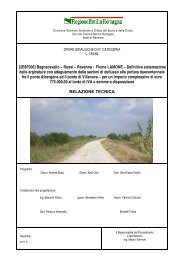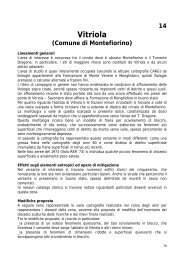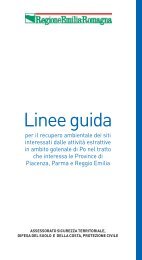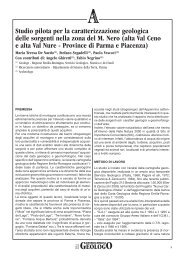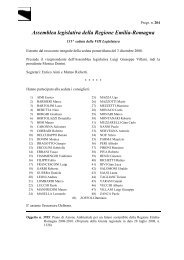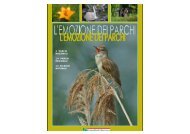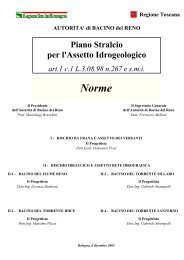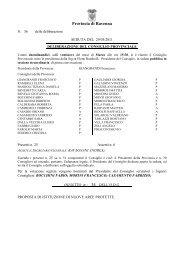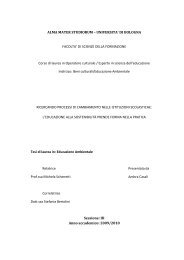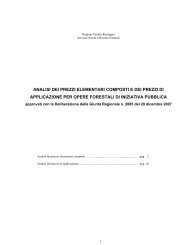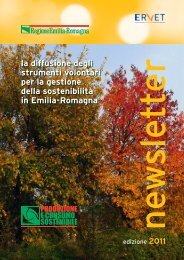air, water and soil quality qualité - ER Ambiente - Regione Emilia ...
air, water and soil quality qualité - ER Ambiente - Regione Emilia ...
air, water and soil quality qualité - ER Ambiente - Regione Emilia ...
You also want an ePaper? Increase the reach of your titles
YUMPU automatically turns print PDFs into web optimized ePapers that Google loves.
Lupicka et al., 1997; Krzysko-Lupicka <strong>and</strong> Sudol, 2008; Obojska et al., 1999; Forlani<br />
G et al., 1999; Obojska et al., 2002; Dick <strong>and</strong> Quinn 1995; Vathanomsat <strong>and</strong><br />
Brown, 2007):<br />
Bacterial strains - (Pseudomonas sp., Agrobacter, Arthrobacter sp., Rhizobium<br />
meliloti, Streptomycin, Escherichia coli, Flavobacterium sp. etc.)<br />
Fungi – Fusarium (Phytopathogenic, potentially dangerous in <strong>soil</strong> environment<br />
(Krzysko-Lupicka <strong>and</strong> Sudol, 2007)), Trichoderma harzianum, Scopulariopsis sp.,<br />
Aspergilus niger, Geobacillus caldoxylosilyticus etc.<br />
Yeasts – (Metal complexes affinity?)<br />
Marine diazotroph Trichodesmium<br />
Cyanobacetria Spirulina spp.<br />
Actynomycete Streptomycete isolates<br />
Unculturable <strong>soil</strong> microorganisms<br />
Glyphosate biodegradation pathways. The pathways <strong>and</strong> rates of microbial degradation<br />
in the environment will depend on a wide range of factors regulating microbial<br />
population, size <strong>and</strong> ability to metabolize (Warren et al., 2003). Two major<br />
mechanisms have been described for the utilization of phosphonates by microorganisms:<br />
AMPA pathway due to C-N cleavage by oxidoreductase flavoprotein;<br />
Sorcosine pathway due to C-P cleavage, the product of degradation is glycine.<br />
(Gimsing et al., 2004; Warren et al., 2003; Dyhrman et al., 2006; Hayes et al.,<br />
2000; Liu et al., 1991; Rueppel ML et al., 1977; Lipok et al., 2007; Krzysko-<br />
Lupicka <strong>and</strong> Sudol, 2008; Krzysko-Lupicka et al., 1997; Obojska et al., 1999; Forlani<br />
G et al., 1999; Obojska et al., 2002; Dick <strong>and</strong> Quinn 1995)<br />
Environmental fate of metabolites<br />
There is still a lack of data for better underst<strong>and</strong>ing of environmental fate of<br />
AMPA (Peruzzo et al., 2008). Till know we know that AMPA is slow degraded as<br />
glyphosate, but there is not enough data about AMPA accumulation. There are still<br />
questions to be answered e.g. Should be AMPA considered as POP? What about<br />
other glyphosate metabolites?<br />
Surface run-off. In some previous study the lack of runoff for glyphosate was observed,<br />
probable due to the tight bonding to the <strong>soil</strong> (Rueppel ML et al., 1977).<br />
Since glyphosate is <strong>water</strong> soluble there is a potential risk of run-off in the case of<br />
erosive precipitations very soon after the herbicide application <strong>and</strong> in the regions<br />
with high risk of run-off.<br />
Field experiments conducted in Kirchberg after corn yield (Stiria/Austria) on<br />
cambisol <strong>and</strong> Pixendorf after cereal yield on chernozem (Lower Austria/Austria) in<br />
September 2008 using a rainfall simulator under worst case scenario (e.g. 50 mm<br />
rain in 1 hours immediately after glyphosate application) showed following results:<br />
107



